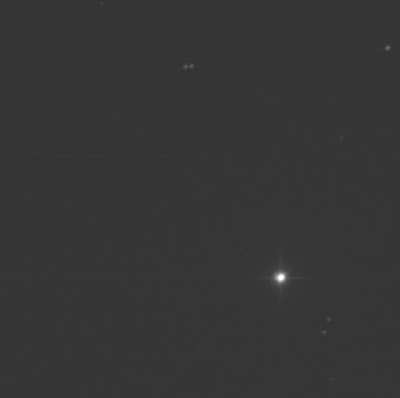Luminance only, 1 second subexposures, 20 stacked shots. FITS Liberator, GIMP. North is up; east is left.
The image below is a detailed crop for the region of interest.
I believe the incredibly faint B companion is visible at the 10 o'clock position, up and left, or north-east of the primary.
B is opposite the star J093534.0+354722 which SkyTools shows is magnitude 14.87. Curiously this dim stars appears to be in a pair with J093533.3+354741 to the north west at mag 15.03. The 11 LMi B element looks dimmer! No wonder I couldn't see it from the backyard. ST3P, by the way, says these stars are 21" apart.
Wikipedia says B is mag 12.5 as does the WDS. SkyTools 3 Pro says 14.0. Maybe it is bright but very close so lost in the glare.
There is a fantastic, interesting tight faint pair of stars far to the north-north-east. ST3P only shows a mag 11.4 single star GSC 02500-0848. Wow. The tight pair is about half the separation as the pair to the south-west, opposite 11 LMi, so about 10".
§
Some additional notes, or said a different way, for clarity.
11 LMi data:
| heading | mag A | mag B | PA° (θ) | sep" (ρ) | as of |
|---|---|---|---|---|---|
| SkyTools 3 Pro | 5.41 | 14 | 49 | 6.60 | 2020.3 |
| Stelle Doppie | 4.8 | 12.50 | 61 | 6.7 | 2012 |
It has an indeterminate Orbit, with a period (P) of 201.0 years and semi-major axis (a) of 3.84".
Note: the ST3P PA and Sep is calculated or predicted.
§




No comments:
Post a Comment